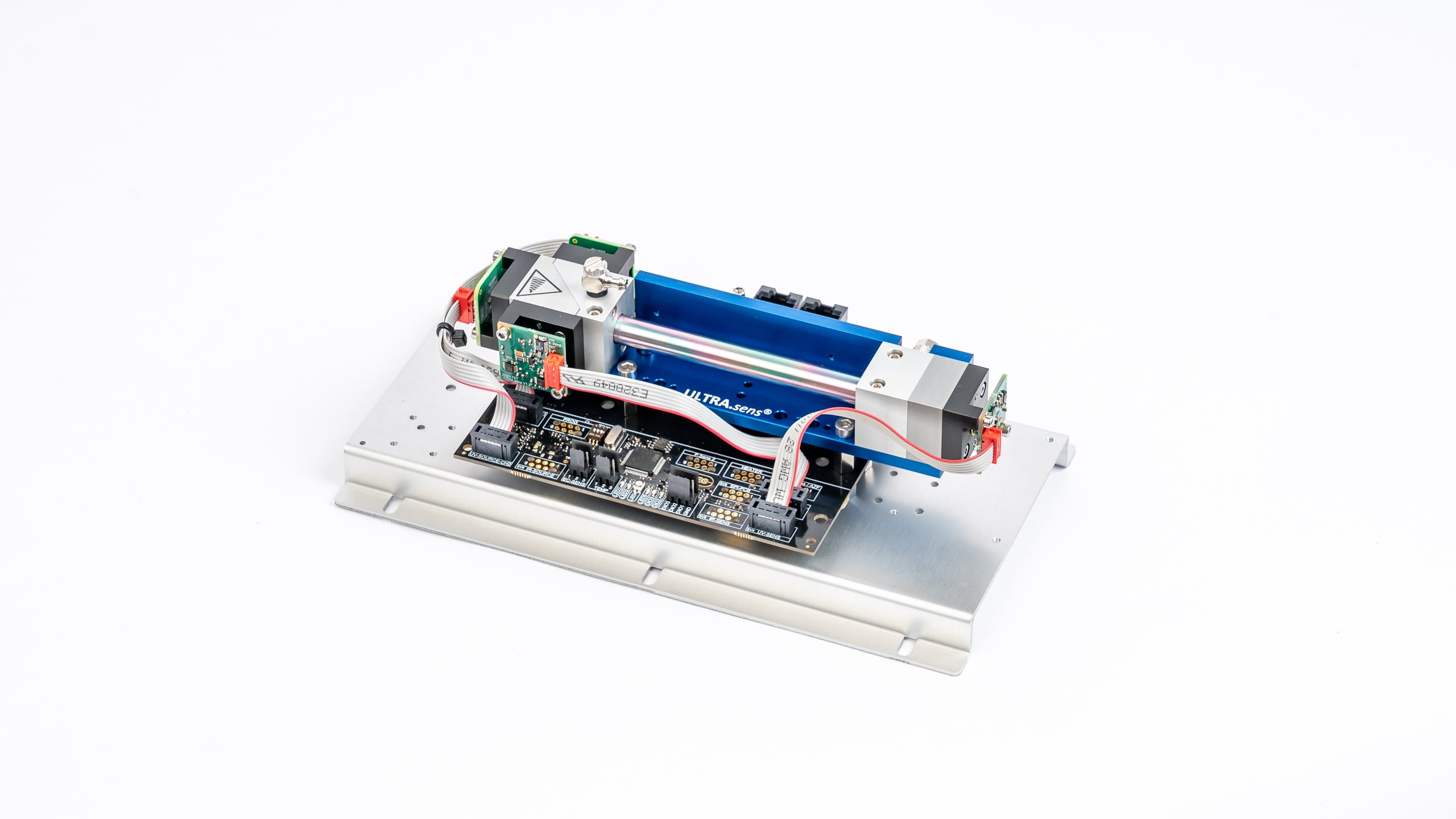Beschreibung
Der RITTER »MultiGas« UV-Sensor ist das weltweit erste Gasanalyse-Modul, welches auf miniaturisierten UV-LEDs basiert. Die Stabilität und Lebensdauer dieser UV-LEDs ermöglicht hochpräzise Gasanalysen bis in den ppm-Bereich. Durch den Einsatz von zwei UV-LEDs können zwei Gase gleichzeitig detektiert werden. Darüber hinaus können mit diesem Ansatz Messbereiche von ppm bis Vol.-% realisiert werden. Im Spektralbereich von 200 nm bis 500 nm können mit dieser neuen Sensorplattform Stickoxide (NO + NO2), aromatische Kohlenwasserstoffe, Schwefelwasserstoff, Ozon, Schwefeldioxid und Chlor zuverlässig nachgewiesen werden. Die gesamte Einheit kann zur einfachen Wartung und Service demontiert werden. Die einzelnen internen Module sind durch O-Ring-Verbindungen abgedichtet. Um eine optimale Anpassung an den gewünschten Messbereich zu erreichen, können die Längen der modularen Messzellen (= Küvetten) im Bereich von 5 mm (großer Messbereich im Prozentbereich) bis 250 mm (kleiner Messbereich im ppm-Bereich) verbaut werden. Bei Küvettenlängen ≥ 20 mm ist die Innenwand mit einer widerstandsfähigen Goldschicht beschichtet, um die Reflexionseigenschaften für den Nachweis niedriger Konzentrationen zu verbessern. Die mechanischen Innenteile sind aus Aluminium gefertigt, optional ist auch Edelstahl verfügbar. Für Anwendungen mit hohen Ansprüchen an die Reaktionszeit liefert das Messsystem ein stabiles Ergebnis innerhalb von t90 ≈ 1-2 Sekunden.Anwendungen
Spezifikationen
Allgemeine Merkmale
| Messtechnik: | Innovativer NDUV-Sensor (nicht-dispersiver Ultraviolett Sensor) |
| Analysierbare Gase: | O3 CL2 SO2 H2S NO2 |
| Anzahl der gleichzeitig analysierbarer Gase: | max. 2 |
| Messbereiche: | Siehe Tabelle der Messbereiche |
| Volumenstrom-Bereich: | 5 ~ 300 ltr/h Für höhere Durchflussraten kann der Sensor im Bypass betrieben werden. |
| Max. Gas-Eingangsdruck: | 300 mbar |
| Druckverlust (ohne optionale Sensoren): | 10 @ 100 / 35 @ 200 / 70 @ 300 (mbar @ ltr/h) |
| Temperaturausgleich: | Ja |
| Software zur Datenerfassung: | Ja |
| Lebensdauer der UV-Strahlungsquelle: | > 8 000 h |
| Messküvette: | Edelstahl mit Silikonbeschichtung innen |
| Küvettendichtung: | Viton O-Ring |
| Interne Verschlauchung: | FKM / Viton (Fluorkautschuk) |
| Gehäuse: | Hochwertiges Tischgehäuse, Aluminium |
| Abmessungen (B x H x L): | 464 x 189 x 305 mm |
| Gewicht: | ca. 6,5+ kg |
| Gasanschlüsse: | PVDF-Schlauchverschraubung für Schlauch Øi 4 mm, Øa 6 mm |
Messdaten
| Linearitätsfehler: | < ± 1% MBEW (F.S.) |
| Wiederholgenauigkeit: | ± 0,5% MBEW (F.S.) |
| Langfrist-Stabilität Nullpunkt: | < ± 1% MBEW (F.S.) / 24 h |
| Langfrist-Stabilität Messbereich: | < ± 1% MBEW (F.S.) / month |
| Temperatureinfluss auf Nullpunkt: | < 1% MBEW (F.S.) / 10K |
| Temperatureinfluss auf Messbereich: | < 2% MBEW (F.S.) / 10K |
| Querempfindlichkeit: | < 2% MBEW (F.S.) |
| Druckeinfluss: | < 1,5% / 10 hPa vom Messwert |
| Aufwärmzeit: | 1 min (Inbetriebnahme), < 60 min für volle Spezifikation |
| Ansprechzeit (t90): | 1,5 – 15 sec |
| Abtastfrequenz durch Software: | ≤ 10 Hz |
| Nachweisgrenze: | Siehe Tabelle der Messbereiche |
| Auflösung: | 0,5 x Nachweisgrenze |
Elektrische Merkmale
| Stromversorgung: | 24 VDC inkl. Netzstecker 100 ~ 240 VAC 50/60 Hz: 24 VDC |
| Stromaufnahme (Spitze) | < 0,4 A |
| Durchschnittliche Leistungsaufnahme | < 7,5 W |
| Schnittstellen: | USB (Standard) RS232 / CANbus / CANopen (optional) inkl. Datenübertragungskabel 1 m |
| Analoger Spannungsausgang (Option): | 0-2 V / 0-5 V / 0-10 V |
Gas-Parameter
| Betriebstemperatur: | +25 ~ +45 °C |
| Lagertemperatur: | –20 ~ +60 °C |
| Betriebsdruck: | 800 ~ 1200 hPa (mbar) |
| Umgebungsfeuchtigkeit: | 0 ~ 95% rel. Luftfeuchtigkeit Kondensatbildung im Inneren des Sensors muss verhindert werden! |
Liste der Standard-Messbereiche *1 ( und Nachweisgrenzen *2 )
| Standard-Messbereiche mit jeweiligen Nachweisgrenzen ( % vom MBEW *3 ) | ||||||||||||||||
|---|---|---|---|---|---|---|---|---|---|---|---|---|---|---|---|---|
| 100 Vol.% | 50 Vol.% | 30 Vol.% | 20 Vol.% | 10 Vol.% | 5 Vol.% | 1 Vol.% | 5.000 ppm | 2.000 ppm | 1.000 ppm | 500 ppm | 300 ppm | 100 ppm | 50 ppm | 10 ppm | 1 ppm | |
| O3 | (< 0,1%) | (< 0,1%) | (< 0,1%) | (< 0,2%) | (< 0,5%) | (< 0,5%) | (< 0,5%) | |||||||||
| CL2 | (< 0,1%) | (< 0,1%) | (< 0,1%) | (< 0,1%) | (< 0,1%) | (< 0,1%) | (< 0,1%) | (< 0,2%) | (< 0,5%) | |||||||
| SO2 | (< 0,1%) | (< 0,1%) | (< 0,1%) | (< 0,1%) | (< 0,1%) | (< 0,1%) | (< 0,1%) | (< 0,1%) | (< 0,5%) | (< 0,5%) | (< 0,5%) | |||||
| H2S | (< 0,1%) | (< 0,1%) | (< 0,1%) | (< 0,1%) | (< 0,2%) | (< 0,5%) | ||||||||||
| NO2 | (< 0,1%) | (< 0,1%) | (< 0,1%) | (< 0,2%) | (< 0,2%) | (< 0,5%) | (< 0,5%) | (< 0,5%) | ||||||||
| NO | (< 0,1%) | (< 0,1%) | (< 0,1%) | (< 0,2%) | (< 0,2%) | |||||||||||
Infrarot-Modul NDIR Ultraviolett-Modul NDUV
Definition der Nachweisgrenze
Die Nachweisgrenze ist der kleinste Messwert, der mit einer bestimmten Unsicherheit ermittelt werden kann. Diese Unsicherheit beinhaltet die Auflösung, das Rauschen und die Stabilität des Gassensors für ein bestimmtes Gas und einen bestimmten Messbereich. Zur Ermittlung der Nachweisgrenze werden mehrere Einzelmessungen unter identischen Messbedingungen durchgeführt. Mit den erhaltenen Werten der Einzelmessungen wird die Standardabweichung "Sigma" (σ) berechnet. Die in der Tabelle angegebenen Werte entsprechen dem dreifachen Betrag von Sigma.
Rekalibrierung
Für UV-Sensoren werden folgende Rekalibrierungs-Intervalle empfohlen:
V 1.0 / Rev. 2023-05-10 / Änderungen vorbehalten.
https://www.ritter.de/multigas-nduv-ultraviolett-module/
Dr.-Ing. RITTER Apparatebau GmbH & Co. KG · Coloniastrasse 19-23 · D-44892 Bochum · Germany
Bei Fragen wenden Sie sich bitte an mailbox@ritter.de oder an Ihren lokalen Vertriebspartner (auf unserer Übersichtsseite)


